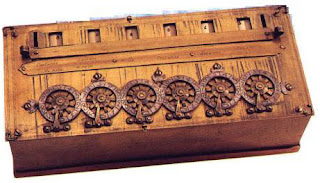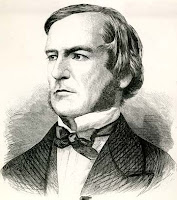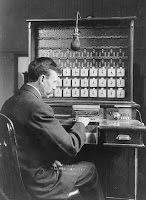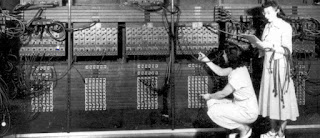HISTORY OF COMPUTER
The need to
keep a track of numbers led to the invention of different counting devices. Right
from Abacus the first counting device; many devices were invented, leading to
the development of computers.
3000 BC ABACUS
Abacus was the
first mechanical device for calculations developed in China.
It is made up
of a wooden frame with rods, each having heads.
The frame is
divided into two parts- Heaven and Earth.
Each rod in
heaven has 2 beads and the Earth has 5 beads.
It is used for
addition, subtraction, multiplication and division.
A skilled user
can solve problems nearly as fast as somebody with a calculator.
PASCAL ADDING MACHINE
Blaise Pascal,
a French mathematician invented the first mechanical calculator at the age of
19 in the year 1942.
It used gears,
wheels and dials.
Numbers were
displayed by rotating the wheels.
It was capable
of performing addition and subtraction.
The gear
principle was further employed in many mechanical calculators. Taxi meter is a
perfect example of it.
LEIBNIZ CALCULATOR
Leibniz, the
famous German mathematician improved on Pascal’s machine in 1671. Leibniz calculator
was a mechanical device.
Apart from
performing addition and subtraction, the Leibniz calculator could even do
multiplication, division and find square roots.
CHARLES BABBAGE
Charles Babbage,
a British mathematician, is considered as the father of computers.
He invented a
working model of mechanical computer, called the Difference engine in 1822 and
the Analytical engine in 1833.
These units
worked like the modern computer. All the computers which are used nowadays are
based on it.
Store was used
for storing the data and Mill was the Calculating Unit.
Control unit
was used for supervising all the units.
AUGUSTA ADA LOVELACE
Lady Augusta
Ada Lovelace was an English mathematician and writer chiefly known for her work
on Charles Babbage’s analytical engine. She is considered as the “First
Programmer” who suggested Binary Data storage (0 or 1) instead of decimal
number system.
GEORGE BOOLE
He solved
mathematical problems by reducing them to a series of positive or negative
answered questions and linked them with the binary system. It resulted in 1 for
positive answers and 0 for negative answers. This system, known as the Boolean
Logic, became the fundamental principle for the design of computer circuits.
DR. HERMAN HOLLERITH
Herman Hollerith,
an American statistician, invented a machine called “Tabulating Machine”.
Tabulating
machine was capable for reading data, processing data results it and giving the
desired best output result.
The input was
given through punched cards.
The punched
cards were used to record and store data or information.
JOHN VON NEUMANN
A modern type
computer come into existence with John von Neumann’a development of software written in binary
code. It was Von Neumann who started the practice of storing data and
instructions in binary code in memory. He also initiated the use of memory to
store data as well as program. Neumann joined hands with Eckert and Mauchly in
a consulting role and EDVAC was built using binary code in 1950.
HOWARD AIKEN
Howard Aiken
was the primary engineer in IBM, who developed the first automatic
sequence-controlled calculator, the Mark 1 in 1944.
ENIAC (Electronic Numeric Integrator And Calculator)
The first
general purpose electronic digital computer was invented by John Mauchly and J.
Presper Eckert. It consisted of 18000 vaccum tubes and was 1000 times faster
than the Mark 1.
UNIVAC 1 (Universal Automatic Computer 1)
The
first commercial electronic computer was also developed by J. Presper Eckert
and John Mauchly in 1951. It was also the first computer to handle both numeric
and text data.











Comments
Post a Comment